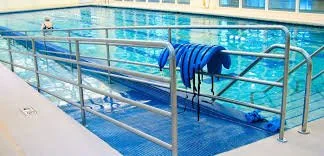Handicap accessibility, is it just about getting in?
Make It Stand Out.
According to the Americans with Disabilities Act (ADA), a "large" pool (over 300 linear feet of wall) must have two accessible means of entry for people with disabilities, while a smaller pool only needs one, with each means of entry typically being a pool lift or a sloped entry; meaning that multiple people with disabilities can access the pool at once depending on the pool size and accessibility features available.
Key points about ADA pool accessibility:
Large pools: Must have two accessible entry points, usually a pool lift and a sloped entry.
Small pools: Need one accessible entry point, either a pool lift or a sloped entry.
Accessible means of entry: This can include pool lifts, sloped entries, transfer walls, or transfer systems depending on the pool design.
Fitness facilities have potential to serve as places of ‘health enhancement’ for many underserved populations, particularly among people with physical/mobility disabilities where walking outdoors to meet recommendations for regular physical activity is not an option due to mobility or safety issues.
Objective
To examine the accessibility and usability of fitness facilities across the U.S. from a broader framework of physical and program access.
Methods
A convenience sample of 227 fitness facilities in 10 states were assessed by trained evaluators using the Accessibility Instrument Measuring Fitness and Recreation Environments (AIMFREE) tool. Non-parametric tests were performed to determine whether AIMFREE section scores were different by geographic region (urban, suburban), business type (nonprofit, for-profit), facility affiliation (fitness center/health club, park district/community center, hospital/rehabilitation facility, university/college), and facility construction date (pre/post passage of the Americans with Disabilities Act, ADA). Raw scores were converted to scaled scores with higher scores indicating better accessibility based on a criterion-referenced approach.
Results
Section scale scores (11/13) were low (<70) with differences found across facility affiliation. While facilities built after passage of the ADA had higher accessibility scores compared to pre-ADA facilities, only programs and water fountains had scaled scores ≥70 regardless of facility construction date.
Conclusions
There exists a strong and urgent need to encourage owners and operators of fitness facilities to reach a higher level of accessibility. Until then, many people with physical/mobility disabilities will continue to have limited access to programs, equipment, and services offered at these facilities.
In addition
Many Handicap and resource therapy locations do not have a pool dedicated to their clients. With your Help we can combine resources to ensure all those who would benefit from Water Based Therapies Have access. We will In addition bring our cause to the Federal Government to ensure Grants are made available and used to promote these changes.
site source https://www.sciencedirect.com/science/article/pii/S1936657416301868
